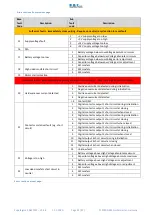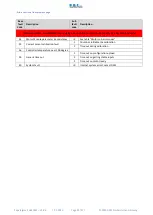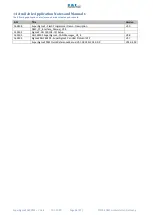
SuperSigma2 AM PMS
–
V1.5.6 17-1-2020
Page 87 (97)
©2019 DMC GmbH Herten Germany
M9-1
CAN Node Number
“
CAN node
”
This sets the CAN node number for the controller.
•
If set to
0 (Master)
, then this controller is responsible for the following:
I.
Manage the General Indication Field as described in
(Traction)
or “
(Pump);
II.
Transmit the BDI information to the Sigmagauge or DMC Display;
III.
Transmit the BDI information to all other controllers (slaves), attached to the CANbus;
IV.
Check the state of all slaves when a shared line contactor is used;
V.
Control the line contactor when a shared line contactor is used;
VI.
Transmit device, fault code and sub code and pulsing information to the Sigmagauge or the DMC
Display.
•
If set from 1 to 15, the controller will be a slave.
In multiple controller systems, it is essential that all CAN nodes have a unique number.
A slave uses the BDI information received from the master, so it disregards its own BDI Menu and associated settings;
however its own BDI cut-out levels
and
still apply.
In this way all devices in the CAN network have the same BDI information, but each controller can set up its own cut-out
and speed levels.
All slaves send out their device, fault code and sub code and pulsing information to the Sigmagauge or DMC Display.
In a non-CANbus system, the controller(s) should have this parameter set to 0. This is particularly important if the BDI is
used, as the BDI calculation will not work when a controller is set up as a slave.
M9-2
CAN bit rate
“
CANbitRt
”
It changes the Can communication rate of the controller:
•
If set to
0
, the bitrate is 100 kbit/s
•
If set to
1
, the bitrate is 125 kbit/s
•
If set to
2
, the bitrate is 250 kbit/s
The change is active only after a key power off-on cycle.
! VERY IMPORTANT if the bit rate of the controller is changed also the calibrator bit rate has to be
changed to communicated again with the controller.
To change the calibrator bit rate follow this procedure:
1)
Press and hold the SEL button for more than 2 seconds in order to return to the calibrator
’s
main page.
2)
Scroll with
button to “About & Setup” menu
; this is the calibrator menu for info and bit rate setup.
3)
Press SEL and information about calibrator will appear.
4)
Press
or
to increase or decrease the CAN bitrate.
5)
When the desired bit rate is displayed cycle the key of controller for resetting the calibrator.
6)
The calibrator at new power up will operate on CAN bus at the selected bit rate.
! VERY IMPORTANT If the calibrator bit rate and controller bit rate are set in a not consistent way the
calibrator is not communicating with the controller.
M9-3
Transmit/Receive CAN messages
“CANMsgs”
This setting allows to select the activation of the CAN HMI protocol.
•
If it is set to
4
, the CAN HMI (Human Machine Interface) is not active. If it is set different from 4 shared line
contactor, sigmagauge, DMC Display and multicontroller BDI management are not available.
•
If it is set
from 5 to 11
, CAN HMI messages will display several information on CAN BUS.
•
If it is set
from 0 to 3
, CAN HMI allows Control Via Can of the Supersigma2 Controller.
Using CAN HMI messages allows to insert the controller in an existing CAN network with third party devices. Refer to [2]
for all details.
M9-4
Shared Line Contactor
“
ShareLC
”
This sets whether the controller has to share a line contactor with another controller(s) in a CANbus network.
The “Shared
Line Contactor” function is managed by the Controller which is set up to be the Master (“

























